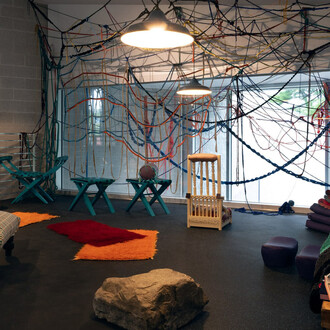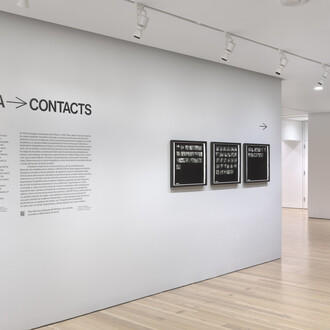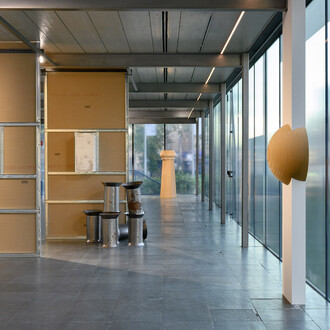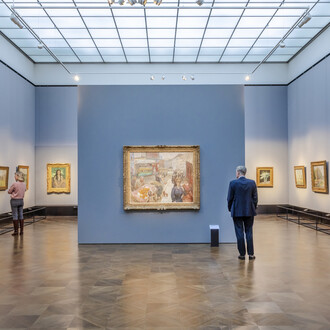The starting point for this exhibition was a dinner amongst the dinosaurs at the Natural History Museum. The fund-raising event related to the new galleries to be built for the purposes of displaying aspects of the world’s most comprehensive collection of paintings, drawings, journals and watercolours, as well as photographs and other modern imaging techniques, all depicting the countless fauna and flora of this earth from the 17th Century to the present day.
Enticing the guests with hitherto unseen treasures, curators had made a marvellous selection from the protective boxes in their vast archive. The Images of Nature Galleries finally opened in 2011, and have hosted an illuminating series of changing exhibitions, currently focusing on the Art of India: Empire and the Natural World. A contemporary artist from India, Sunoj D, has been invited to exhibit his personal response to the Museum’s India collection.
With reams of information and debate about climate change and global warming, Natural History as a science is expanding rapidly and has never been more relevant. This summer, Art First has invited gallery and guest artists whose practices both question and celebrate the diversity of our natural world to contribute work especially for this exhibition.
The selection is personal rather than definitive. There is less of a curatorial ‘mission’ and more of a tribute to the acute observational powers and the depth of visual thinking that artists bring to this subject. As the planet is more closely observed, measured, abused, protected, catalogued, recorded, and explored, artists and scientists are collaborating more and more closely to document their findings in a compelling and communicative fashion.
The United Kingdom has led the way over centuries, from around 1650 onwards. To get some sense of this, you only have to think of the Chelsea Physic Garden, The Oxford Botanic Garden, the Royal Botanic Gardens in Kew, the Royal Botanic Garden in Edinburgh, and then Gilbert White’s House and Garden in Selborne, Darwin’s Garden at Down House, and Alfred Russel Wallace’s increasing online presence, among many others.
Currently, Sir David Attenborough is the world’s best-‐known natural history film maker and naturalist broadcaster. Working with the BBC’s Natural History Unit in Bristol, his landmark film series span forty years and include Life on Earth, The Living Planet, the Private Life of Plants, The Life of Birds, of Mammals, Life in the Undergrowth, in Cold Blood and then from 2001, Planet Earth, The State of the Planet, The Truth about Climate Change and Saving Planet Earth, forming a crescendo of heightened awareness and intensity.
In this exhibition there is a focus on artists working in the UK, with contributions from South Africa, where Karel Nel and Joni Brenner are based. Nel is resident artist with the COSMOS Project, working closely with astrophysicists to measure two square degrees of the universe. For this he creates works made using 500 million year old carboniferous coal dust, and salt crystals harvested in Namibia. Nel and Brenner collaborated on a body of work called Life of Bone, shown recently at the Origins Museum in Johannesburg, and both artists are engaged in the findings of the paleontologists /archeologists, genetic scientists and geologists based in Southern Africa and the rest of the continent.
Moved by the recent disaster on the English West Coast which affected the Guillemot birds, Will Maclean is creating a mixed media work in response. The birds – their eggs, feathers and features -‐ have often appeared in his work over the years, especially in relation to the St Kilda series. Also from Scotland is Eileen Lawrence, whose interest in birds and their habitats is registered in the form of tall ‘prayer stick’ arrangements with detailed depictions in watercolour of eggs, feathers, grasses, placed vertically as if stacked by a naturalist collector.
Helena Goldwater recently paused from her practice as a performance artist to train as a botanical painter, but her precise watercolours depart from any scientific purpose to describe instead imaginary hybrid plants, most of which relate to water, and with titles that evoke their anthropomorphic ‘attitudes’. Dame Elizabeth Blackadder on the other hand, paints the flowers she loves and knows from her own garden and in her home. Her work over decades has become synonymous with the velvety fragile forms of irises, tulips and anemones, painted in loose arrangements, completely liberated from the tighter formal compositions deployed by the traditional botanical painter.
Gillian Barlow is a leading painter in the botanical field, recently returned from a project in Transylvania, and well known at Kew and in all key botanical circles. Equally placed in zoological circles is Elizabeth Butterworth, whose specialist knowledge of parrots is evident in her impeccable watercolour of Edward Lear’s Blue Macaw, now a threatened species in Brazil, but in the 1830’s when Lear himself depicted the Macaw (it was named after Lear), the bird was a well cared for member of the Earl of Derby’s extensive Aviary at Knowsley Hall.
Simon Morley’s approach is more conceptual; he has painted the book cover of Rachel Carson’s groundbreaking Silent Spring, published in 1962, which was instrumental in launching the environmental movement in the U.S.A. Morley’s choice of a hot orange monochrome conveys the exposure of damage caused by unmonitored use of insecticides at the time. Simon Lewty, also a text based artist, brings a very different kind of writing to the topic through his contemplative calligraphic surface with poetic evocations contained within the body of the text. Liz Harrison has painted a trilogy of written pages from her journal of a childhood garden remembered. Birdsong and the impact of urban environments on natural phenomena are a core interest, and her award-‐winning project for Deptford X in 2010 was a sound installation, How Birds Sing Up in Deptford Railway Station.
Books have their content liberated by Jack Milroy as he applies his scalpel to cut and fold the illustrated creatures allowing them to move through opened pages balanced in a weightless space of their own. Books on insects, snakes, birds, and every form of life have been his favoured subject for years, and he both edits and exposes the content in dynamic, often subversive ways.
In addition there is Lino Mannocci’s delicate painting of a cloud, Bridget Macdonald’s majestic drawing of a bull in a flowering meadow, David Price’s sumptuous painting of flowers in full bloom, painted on a polygonal board referencing Northern Renaissance interests, Donald Teskey’s close up rendering of the Gearagh, in his Nature Reserve series following a residency in Co. Cork’s remains of an alluvial oak forest, Rebecca Partridge’s tree branched against sky, Anya Gallaccio’s small box of acorns, Christine Borland’s etchings based on a 16th Century History of Plants by Leonhart Fuchs, Barry Thompson’s exquisite, tiny drawing of a Sparrow, Kim Wolhuter’s photograph of a wild pup on parched earth which won the 2012 Gerald Durrell award for threatened species, Mimei Thompsons’s urban weeds embellishing a structured corner, Susan Michie’s rhythmic dotted marks registering a leaf form, the binary pencil drawings of Highland plants by Helen MacAlister, Alan Kilpatrick’s Anonymous Series in henna, spices and incense evoking plants from the Calcutta Botanical Garden’s archive, and Brad Hammond’s Mustard Hedge from the open grasslands in NSW, Australia, drawn with reed pens made from bulrushes.
Works in stone by Jake Harvey, in clay by Joni Brenner and in mixed media and traditional materials, will steer the viewer in new directions, expanding our thinking and inspiring us to take notice of this kaleidoscopic subject, familiar to everyone, but which all too often is taken completely for granted.
Art First Gallery
21 Eastcastle Street
London W1W 8DD United Kingdom
Ph. +44 (0)20 77340386
info@artfirst.co.uk
www.artfirst.co.uk
Opening hours
Tuesday - Friday from 10am to 6pm
Saturday from 11am to 4pm and by appointment














